On May 7th, 1918, at a meeting of nearly one hundred Lutheran
pastors, members of nearly all of the synods represented on this territory, there was organized a “Conference of the Lutheran pastors of the Metropolitan District for the discussion of all questions of doctrine and practice to the end of effecting unity.” This, too, is a harbinger of an approaching era of reconstruction and peace.
The Problem of Language
It was a Lutheran demand in the sixteenth century to preach the Gospel in the vernacular. It would be un-Lutheran in the twentieth century to conduct public worship in a language which the people do not understand.
This lesson is written so plainly in the history of our churches in America that “he may run that readeth.” The Swedish churches on the Delaware, planted by Gustavus Adolphus for the very purpose of propagating the faith in America, were all of them lost to the Lutheran church because the persistent use of the Swedish language, and the inability of the pastors to preach in English, proved an insuperable obstacle to the bringing up of the children in the Lutheran communion. When the New York Ministerium at its meeting in Rhinebeck, September 1st, 1797, resolved that it would “never acknowledge a newly-erected Lutheran Church merely English in places where the members may partake of the services of the Episcopal Church, it halted for a century the growth of the Lutheran Church in New York. [Tr. note: no close quotation marks in original.]
The same experience greets us in London. There the Lutheran Church was established in 1669, only five years later than in New York. For more than two centuries it had the recognition of royalty. As late as the Victorian era Prince Albert, the Queen and the royal family, in their personal relations, were connected with the Lutheran Church. To this day Queen Alexandra is a communicant in the Lutheran church. There exist therefore no social barriers to its growth. Yet not a single English Lutheran church is to be found in London.
With one exception the dozen Lutheran churches of other tongues recognize no responsibility to propagate the faith of the Augsburg Confession in the language of the city in which they live. The exception is that of the German “Missouri” congregation. Here English as well as German is used in the services. Here alone it would seem that “religion is the chief concern.”
The language problem confronted us early in our local history. In the first hundred years three languages, Dutch, German and English, contended for the mastery. In their pastoral work some ministers used all three.
Dutch was the first to surrender. The children of Dutch families adopted the language of their English conquerors, and when immigration from Holland ceased, the use of Dutch in worship became obsolete. The last use of Dutch at a Lutheran service was at the communion on the First Sunday in Advent in 1771. It had maintained itself for 114 years.




